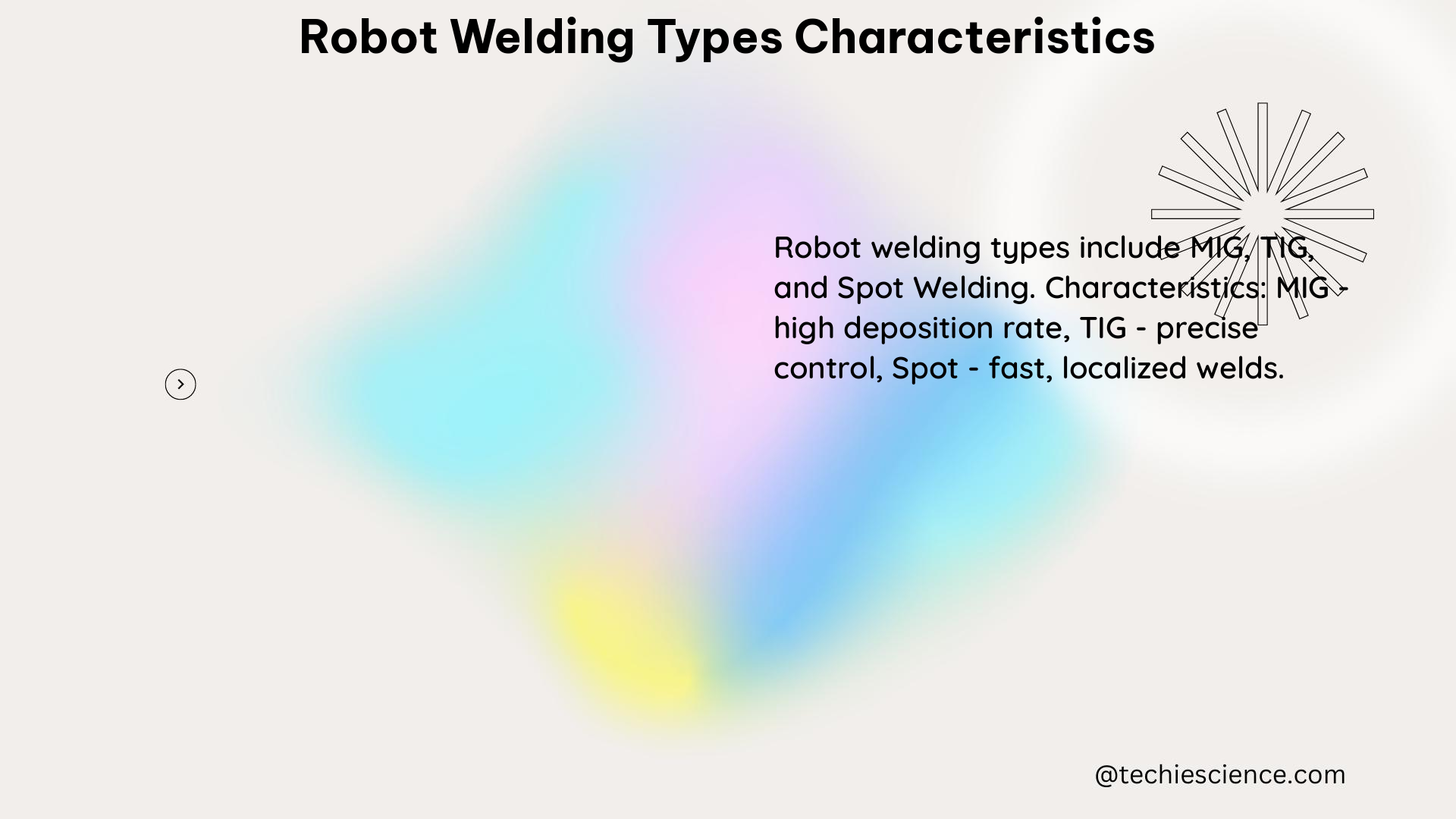Robot welding is a highly specialized and technologically advanced field that involves the use of robotic systems to perform various welding tasks. These robotic welding systems are characterized by a range of measurable parameters and characteristics that are crucial for understanding their performance, efficiency, and quality of the welded joints. In this comprehensive guide, we will delve into the intricate details of different robot welding types and their corresponding characteristics.
Arc Welding Robot Characteristics
Arc welding robots are a popular choice for automated welding applications due to their versatility and precision. These robots are characterized by the following key parameters:
-
Voltage: The voltage range for arc welding robots typically falls between 10-40 V, depending on the specific welding process and the material being joined. This voltage is essential for generating the necessary arc energy to melt the base metal and filler material.
-
Current: The welding current for arc welding robots can range from 50 A to 500 A, again depending on the welding process and the material being joined. The current is a critical parameter that determines the heat input and the rate of metal deposition.
-
Digital Signal: Arc welding robots utilize digital signals for real-time monitoring and control of the welding process. These digital signals allow for precise control over the welding parameters, ensuring consistent and high-quality welds.
-
Weld Pool Monitoring: Arc welding robots often incorporate advanced sensors and algorithms to monitor the weld pool in real-time. This data-driven approach enables adaptive control, where the welding parameters can be adjusted on the fly to maintain optimal weld quality.
-
Welding Speed: The welding speed for arc welding robots can range from 1 mm/s to 10 mm/s, depending on the material, joint design, and desired weld quality. Precise control over the welding speed is crucial for achieving consistent and defect-free welds.
-
Shielding Gas Flow Rate: The shielding gas flow rate for arc welding robots typically ranges from 10 L/min to 50 L/min, depending on the specific welding process and the material being joined. The shielding gas plays a vital role in protecting the weld pool from atmospheric contamination, ensuring the integrity of the weld.
Robotic GMA Welding Characteristics

Robotic Gas Metal Arc (GMA) welding is another widely used technique in automated welding applications. The key characteristics of robotic GMA welding include:
-
Welding Speed: The welding speed for robotic GMA welding can range from 1 mm/s to 10 mm/s, depending on the material, joint design, and desired weld quality.
-
Welding Current: The welding current for robotic GMA welding can range from 50 A to 500 A, depending on the material and the desired weld quality.
-
Arc Voltage: The arc voltage for robotic GMA welding typically falls within the range of 10-40 V, depending on the material and the desired weld quality.
-
Shielding Gas Flow Rate: The shielding gas flow rate for robotic GMA welding can range from 10 L/min to 50 L/min, depending on the material and the desired weld quality.
-
Weld Pool Monitoring: Robotic GMA welding systems often incorporate advanced sensors and algorithms to monitor the weld pool in real-time, enabling adaptive control and ensuring consistent weld quality.
Microstructural Analysis of Robotic Welds
Analyzing the microstructure of robotic welds is crucial for understanding the quality and performance of the welded joints. Two key techniques used for this purpose are:
-
Scanning Electron Microscopy (SEM): SEM is a powerful tool used to analyze the microstructure of the weld, providing detailed information about the grain structure, defects, and other microstructural features.
-
Energy Dispersive Spectroscopy (EDS): EDS is a complementary technique used in conjunction with SEM to analyze the elemental composition of the weld, which is essential for understanding the metallurgical properties and potential defects.
Tensile Characteristics of Robotic Welds
The tensile characteristics of robotic welds are crucial for determining the structural integrity and load-bearing capacity of the welded joints. The key tensile characteristics include:
-
Tensile Strength: The tensile strength of robotic welds can range from 500 MPa to 1000 MPa, depending on the material and the quality of the weld.
-
Elongation at Break: The elongation at break for robotic welds can range from 10% to 30%, depending on the material and the quality of the weld.
These tensile characteristics are essential for ensuring the reliability and safety of the welded structures in various applications, such as automotive, aerospace, and heavy machinery.
Data-Driven Process Characterization in Robotic Welding
Advancements in sensor technology and data analytics have enabled a data-driven approach to process characterization in robotic welding. Key aspects of this approach include:
-
Weld Pool Status Monitoring: Monitoring the weld pool status is a critical and measurable metric in all types of welding processes. This data is used to understand the dynamics of the weld pool and optimize the welding parameters.
-
Adaptive Control: Robotic welding systems can utilize the weld pool status data to implement adaptive control algorithms. These algorithms adjust the welding parameters in real-time to maintain optimal weld quality, even in the face of changing conditions or disturbances.
-
Predictive Maintenance: By analyzing the sensor data and weld pool characteristics, robotic welding systems can predict potential issues or defects, enabling proactive maintenance and reducing downtime.
-
Quality Assurance: The data-driven approach to process characterization allows for comprehensive quality assurance, ensuring consistent and high-quality welds across multiple production runs.
Conclusion
In this comprehensive guide, we have explored the various characteristics of different robot welding types, including arc welding robots, robotic GMA welding, microstructural analysis, tensile characteristics, and data-driven process characterization. These quantifiable data points and measurable parameters are essential for understanding the performance, efficiency, and quality of robotic welding systems, ultimately enabling the production of reliable and high-quality welded structures.
References
- Universal Robots. (n.d.). What is Robotic Welding? 7 Popular Robot Welding Types & Process. Retrieved from https://www.universal-robots.com/in/blog/what-is-robotic-welding/
- International Atomic Energy Agency. (1992). Quality Assurance and Control for Robotic GMA Welding. Retrieved from https://inis.iaea.org/collection/NCLCollectionStore/_Public/23/046/23046672.pdf
- ResearchGate. (n.d.). Robotic welding parameters for this study. Retrieved from https://www.researchgate.net/figure/Robotic-welding-parameters-for-this-study_tbl1_317552398
- ScienceDirect. (n.d.). Arc Welding Robot – an overview | ScienceDirect Topics. Retrieved from https://www.sciencedirect.com/topics/engineering/arc-welding-robot
- ScienceDirect. (n.d.). Data-driven process characterization and adaptive control in robotic … Retrieved from https://www.sciencedirect.com/science/article/am/pii/S0007850622000920

I have a background in Aerospace Engineering, currently working towards the application of Robotics in the Defense and the Space Science Industry. I am a continuous learner and my passion for creative arts keeps me inclined towards designing novel engineering concepts.
With robots substituting almost all human actions in the future, I like to bring to my readers the foundational aspects of the subject in an easy yet informative manner. I also like to keep updated with the advancements in the aerospace industry simultaneously.